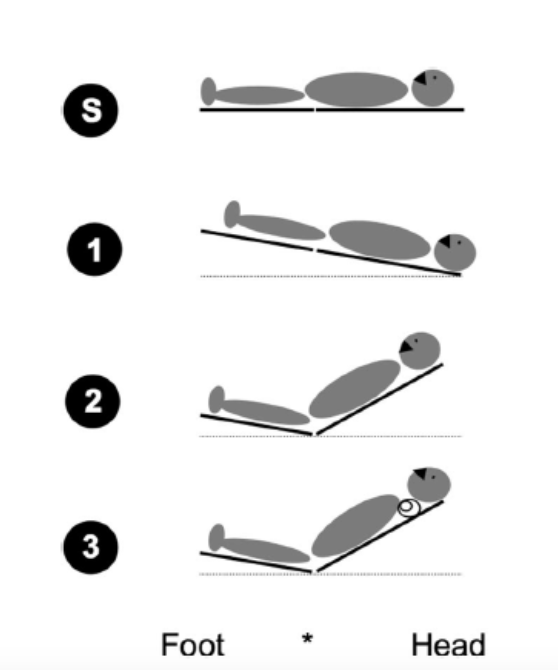Background
Emergent endotracheal intubation has risks of complications including hypoxia, pulmonary aspiration, and prolonged time to intubation. Previous studies from the anesthesiology literature suggests that bed-up head-elevated (BUHE) positioning is associated with improved glottic views and prolonged apnea time. Using this positioning method could lead to decreased complication rates with emergent intubation.
Clinical Question
Is a head-elevated patient position associated with decreased complication rates in emergent tracheal intubation in the ward and intensive care unit?
Population
Patients >18 years old requiring emergent endotracheal intubation
Intervention
BUHE patient positioning at 30 degrees incline (see image below)
Control
Supine patient positioning
Outcomes
(Primary): Occurrence of a composite of any intubation-related complication (difficult intubation, hypoxemia, esophageal intubation, or pulmonary aspiration)
Design
Multicenter, retrospective observational clinical trial. Participants and clinicians were unblinded.
Excluded
Patients < 18 years old, patients in cardiopulmonary arrest, intubations in the ER, OR, or PACU, intubations performed with video laryngoscopy or fiberoptic endoscopy. If patients were reintubated during their hospital stay only initial intubations were included.
Primary Results
-

Bed-Up-Head-Elevated Positioning
1665 intubations examined over 18 months in 2 hospitals
- 1137 intubations excluded (51 involving patients younger than 18, 266 not direct laryngoscopy, 395 performed by EM, 84 performed during CPR, 10 using other airway procedure, 331 due to incomplete charting)
- 528 intubations included in this analysis: 214 patients included in standard group & 214 in modified group
- No significant differences in baseline characteristics (including gender, age, presenting vital signs, and cardiac/medical history)
Critical Findings:
- Primary outcome (> 1 intubation related complication)
- Supine position: 76/336 (22.6%)
- BUHE position: 18/192 (9.3%)
- BUHE position associated with significantly lower odds of reaching primary endpoint.
- OR 0.42; 95% CI 0.23-0.77 p=0.005)
- After adjusting for BMI & MACOCHA (predicted difficult intubation) score
- BUHE position was more commonly performed by senior intubators (>1 year of anesthesiology experience) compared to supine position (93% vs 66%, p<0.0001)
- BUHE position was performed on patients with MACOCHA score >3 in significantly lower number of patients than with supine position (8% vs 19%)
Strengths
- Large, multicenter study
- Study asked a clear, clinically relevant question
Limitations
- Excluded ED intubations limiting applicability to ED patients
- Retrospective, non-randomized nature yielded inequalities in baseline characteristics (training level of intubator, MACOCHA score)
- Subjective to recall/collector bias
- Uncertain degree of patient benefit (unclear how intubation complications translates to length of stay, mortality, etc.)
Author's Conclusions
“Placing patients in a back-up head-elevated position, compared with supine
position, during emergency tracheal intubation was associated with a reduced odds of airway related complications.”
Our Conclusions
There is evidence that BUHE patient positioning may be associated with significantly decreased rates of intubation-related complications during emergent endotracheal intubation in the ward or intensive care unit. A randomized control trial would be needed to suggest clear causal association, but it seems reasonable to use this positioning when not medically contraindicated.
Potential Impact To Current Practice
BUHE position shows promise in reducing adverse events during emergent intubation. If these results are echoed in prospective studies including ED patients, this could lead to a paradigm shift in positioning for RSI.
Bottom Line
This retrospective, observational study demonstrated a lower odds of intubation-related complications in patients placed in the BUHE position for emergent intubation.
Read More
EM Updates: Intubate with the head of the bed elevated
Sinai EM: Keep Your (patient’s) Head Up for better intubations
Hey Folks,
Great stuff! You’ll pretty much never need to pad under the shoulders, except in peds. Padding is going to need to be placed under the occipit. Except in Swami he is perfectly flat in all dimensions.
Glad you enjoyed the post. Hopefully, we achieved correct positioning and yes, I’m fairly flat.
Great!